September 29, 2014
by Carole Zangari -
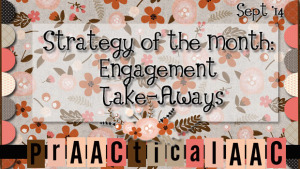
We’ve been musing about engagement this month. Here are some final lessons we’ve learned along the way. “If you don’t believe in me, you won’t be a successful interventionist.” “Put yourself in my shoes once in a while. Be aware of how much focus and effort it takes for me to cope with sensory input, breathe, swallow, and move so that you can plan activities at an appropriate level of difficulty.” “Set a top priority for the lesson, and let me focus on that. It’s hard to sustain interest and motivation when you make things challenging on ALL fronts: cognitive, linguistic, motoric. Pick one area in which to challenge me and let’s dive in!” “Make it worth my while to work hard. We all look for rewards and compensations that are proportionate to the effort expended. I’m no different than you in that respect.” “Use my areas of interest when you... [Read More...]
Filed under: Strategy of the Month
Tagged With: engagement
September 22, 2014
by Carole Zangari -
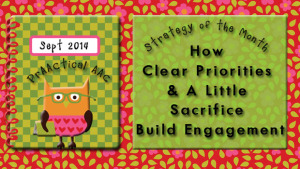
We can’t complete our thoughts on engaging AAC learners without a bit of conversation around the topic of priorities. Here’s the main idea: Go into each activity having a clear priority for what you want to achieve. Everything else become negotiable. As SLPs, sometimes we want it all. We want therapy activities where the AAC learner initiates communications, uses new vocabulary, creates novel sentences, experiments with new grammatical forms, and kicks some morphological butt. We.want.it.all. After a few decades of being an AAC practitioner, I think I’m finally learning that trying to have it all isn’t always the best option. It isn’t about what I want, it’s about what my client needs. Sigh. In this approach, we look at the lesson or activity and create our “Must Have List.’ For Mayra, a kindergartner just learning to use symbols for the first time, our lessons ‘must’ be engaging, have high pay-off... [Read More...]
Filed under: Strategy of the Month
Tagged With: engagement, priorities
September 15, 2014
by Carole Zangari -
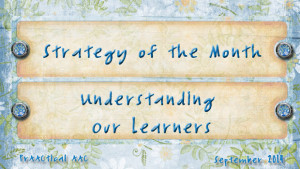
This month, we’re thinking about what it takes to create therapy sessions that engage our AAC learners. A big piece of that is challenging learners at an appropriate level. It’s a simple concept, but can be tricky to translate for an individual learner and task. As much as we try to, it’s hard to really get a feel for what our clients are experiencing. Our bodies work well, for the most part, so we don’t automatically account for differences in sensory processing, motor control, executive functioning, cognition, or memory. We try. We really do. But I’m not sure we do it as well as we hope to do. Revisiting these concepts as an intellectual exercise isn’t going to fix that, but for me (and maybe some of you), it can serve as a helpful reminder. Awareness Ours is an empathetic profession. Still, we don’t always truly understand what our clients... [Read More...]
Filed under: Strategy of the Month
Tagged With: awareness, balance, effort, engagement
September 8, 2014
by Carole Zangari -
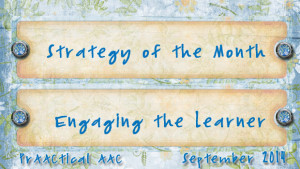
Summer is over in our part of the world and that means we get the opportunity to work with a whole new crop of students and clients. There is so much for beginning clinicians to know about providing AAC services that it is intimidating at best and overwhelming in most cases. In previous posts we’ve written about expectations, goal-setting, intervention strategies, therapy activities, reinforcement, feedback, and the like. This month, we’ll focus on a construct that permeates everything: engagement We all know what it looks and feels like when a client is engaged, but how do we make that happen? Here are some thoughts. 1. Start by presuming that your client is a learner on his/her way to developing competence. Good intervention, consistent language models, the right tools, and plenty of practice will move them along the journey toward improved communication. It’s important that, as clinicians, we truly believe that.... [Read More...]
Filed under: Strategy of the Month
Tagged With: engagement, intervention, presume competence
July 14, 2014
by Carole Zangari -
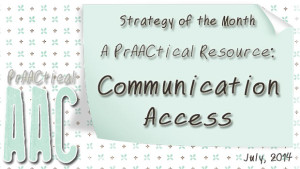
There are some organizations and projects that just amaze us with the work that they do. Today, we are looking at one of those, Communication Disabilities Access Canada, led by Barbara Collier. They have a wonderful array of resources that address important topics related to safety, self-determination, advocacy, and more. Here are two of our favorites. Communication Boards Making and Using Communication Access Cards You can follow them on Facebook, too.
Filed under: Strategy of the Month
Tagged With: accesss, advocacy, Communication Disabilities Access Canada, safety, self-determination
July 7, 2014
by Carole Zangari -
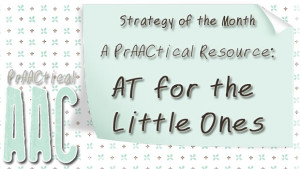
This month we’re sharing resources that have prAACtical applications. Today, we look at a project developed jointly by the Pacer Center and the Tots ‘n Tech Program at Arizona State University. Get your DIY on with EZ AT 2: A Guide for Increasing Young Children’s Participation in Daily Activities and Routines.
Filed under: Strategy of the Month
Tagged With: babies, early intervention, infants, Pacer Center, play, preschoolers, toddlers, Tots and Tech
June 30, 2014
by Carole Zangari -
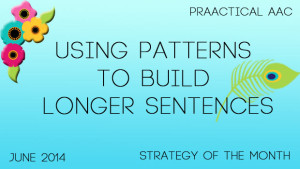
Throughout the month, we’ve been talking about building sentence length and complexity. We’ll end the month with a concept that applies to both beginning communicators and those with more complex language skills. Human beings are pattern-seekers. We notice similarities and distinctions, and compare things that are new to us to things we already know about. As we go through our lives, we draw on our pattern-seeking skills to learn about and understand the world. How can we use this intrinsic trait to help us in teaching language to AAC learners? Consider patterns when choosing your targets: Increasing sentence length is a broad goal that gives us lots of flexibility in how we design our intervention. We can lengthen sentences by adding descriptors, temporal terms, conjunctions, embedded clauses, and more. Within each category, there are many options. For a beginning communicator, we might teach descriptors related to appearance (e.g., size, color,... [Read More...]
Filed under: Strategy of the Month
Tagged With: language intervention, sentence length, sentence structures
June 23, 2014
by Robin Parker -
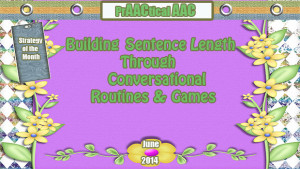
Building sentence length beyond the simple sentence level can be a lot of fun for those of us who love language. Additionally, and even more important, expanded sentences can provide communication impact and power to the communicator. Expanded sentences usually means moving from the simple to complex sentence. As Carole mentioned last week, we often begin with conjunctions like ‘because’, ‘but’, ‘so’, ‘if’, before’, after’. Here are some ideas for conversational routines and games that allow for frequent repetition with variety as well as strong communication power that will help with making it worthwhile to use longer sentences. “Pretty Please” Routine- This routine involves using ‘because’ to negotiate with longer sentences. This routine is reserved for requests that are possible but not always honored. In the case of teaching, we start with requests that can be honored if “pretty please because I worked hard or some other reasonable reason is... [Read More...]
Filed under: Strategy of the Month
June 16, 2014
by Carole Zangari -
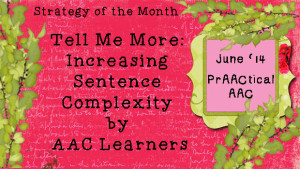
Expanding the length and complexity of sentences is something that SLPs love to work on well beyond the ‘early communicator’ phase, something we talked about a few weeks back. In today’s post, we’ll consider ways to build more complex utterances for learners who are gaining competence with their AAC systems but who still use language that is immature, imprecise, or overly simplistic. In many ways, this therapy is like language therapy for any other learner with delays in grammar, syntax, and morphology. Indeed, we sometimes forget to activate all that we know about language intervention when working learners who use AAC. We try to use that as a starting point and adjust for the AAC components as needed. Here are some of the things that we think about when planning therapy for AAC learners who are trying to strengthen their ability to speak in more complex sentences. Relate the language... [Read More...]
Filed under: Strategy of the Month
Tagged With: intervention, language intervention, sentence length, strategy
June 9, 2014
by Robin Parker -
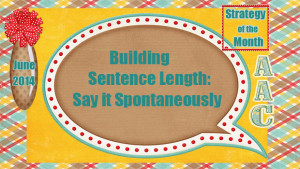
As beginning communicators start using single symbols to communicate, the next step immediately becomes to expand sentence length to two words, then three words, then more. Helping learners to use longer sentences spontaneously is the main goal. Teaching spontaneous use of longer sentences helps assure that those sentences can be used with many communication partners and in many contexts. A great facilitator strategy for helping to build sentences is ‘add a word’ or expansions and extensions. This was mentioned in last week’s post: Helping Beginning Communicators Expand Their Sentence Length but is further delineated below. What is it? ‘Add a word’ strategy is more formally called expansions and extensions. Expansions typically refer to adding a word with new conceptual knowledge while extensions add a word with new grammatical information. Expansions and extensions are a form of modeling and can be done both on a communication display as well as verbally. This... [Read More...]
Filed under: Strategy of the Month
Tagged With: expansions, extensions, Language facilitation strategies









